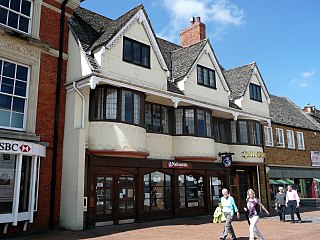Related Research Articles

A building society is a financial institution owned by its members as a mutual organization. Building societies offer banking and related financial services, especially savings and mortgage lending. Building societies exist in the United Kingdom, Australia and New Zealand, and used to exist in Ireland and several Commonwealth countries. They are similar to credit unions in organisation, though few enforce a common bond. However, rather than promoting thrift and offering unsecured and business loans, the purpose of a building society is to provide home mortgages to members. Borrowers and depositors are society members, setting policy and appointing directors on a one-member, one-vote basis. Building societies often provide other retail banking services, such as current accounts, credit cards and personal loans. The term "building society" first arose in the 19th century in Great Britain from cooperative savings groups.

Nationwide Building Society is a British mutual financial institution, the seventh largest cooperative financial institution and the largest building society in the world with over 15 million members. Its headquarters are in Swindon, England.

National Australia Bank is one of the four largest financial institutions in Australia in terms of market capitalisation, earnings and customers NAB was ranked 21st-largest bank in the world measured by market capitalisation and 52nd-largest bank in the world as measured by total assets in 2019. As of January 2019, NAB operated 3,500 Bank@Post locations—including 7,000+ ATMs across Australia, New Zealand, and Asia—and served 9 million customers.
The Abbey National Building Society was formed in 1944 by the merger of the Abbey Road and the National building societies.

Royal Bank of Canada is a Canadian multinational financial services company and the largest bank in Canada by market capitalization. The bank serves over 16 million clients and has 86,000+ employees worldwide. Founded in 1864 in Halifax, Nova Scotia, it maintains a corporate headquarters in Toronto and its head office in Montreal. RBC's institution number is 003. In November 2017, RBC was added to the Financial Stability Board's list of global systemically important banks.

The National Bank of New Zealand Limited (NBNZ), often referred to as The National Bank, was one of New Zealand's largest banks. Throughout much of its history, the National Bank provided commercial banking services to mainly major industrial and rural as well as some personal customers.

Bendigo and Adelaide Bank is an Australian financial institution, operating primarily in retail banking. The company was formed by the merger of Bendigo Bank and Adelaide Bank in November 2007.

The Bank of Queensland is an Australian retail bank with headquarters in Brisbane, Queensland. The bank is one of the oldest financial institutions in Queensland, having begun as a building society, It now has 160 branches throughout Australia, including 65 corporate branches and 95 "owner managed" branches.

Bank of New Zealand (BNZ) is one of New Zealand's big four banks and has been operating in the country since the first office was opened in Auckland in October 1861 followed shortly after by the first branch in Dunedin in December 1861. The bank operates a variety of financial services covering retail, business and institutional banking and employs over 5,000 people in New Zealand. In 1992 the bank was purchased by the National Australia Bank and has since then operated as a subsidiary, but it retains local governance with a New Zealand board of directors.

Permanent TSB Group Holdings plc, formerly Irish Life and Permanent plc is a provider of personal financial services in Ireland.

The Australia and New Zealand Banking Group Limited, commonly called ANZ, is an Australian multinational banking and financial services company headquartered in Melbourne, Australia. It is the second largest bank by assets and third largest bank by market capitalisation in Australia.

AMP is a financial services company in Australia and New Zealand providing superannuation and investment products, financial advice and banking products including home loans and savings accounts. Its headquarters is in Sydney, Australia.
Banking in Australia is dominated by four major banks: Commonwealth Bank of Australia, Westpac Banking Corporation, Australia and New Zealand Banking Group, and National Australia Bank. There are several smaller banks with a presence throughout the country, and a large number of other financial institutions, such as credit unions, building societies and mutual banks, which provide limited banking-type services and are described as authorised deposit-taking institutions (ADIs). Many large foreign banks have a presence, but few have a retail banking presence. The central bank is the Reserve Bank of Australia (RBA). The Australian government’s Financial Claims Scheme (FCS) guarantees deposits up to $250,000 per account-holder per ADI in the event of the ADI failing.
Suncorp Group Limited is an Australian finance, insurance, and banking corporation based in Brisbane, Queensland, Australia. It is one of Australia's mid-size banks and its largest general insurance group, formed on 1 December 1996 by the merger of Suncorp, Metway Bank and the Queensland Industry Development Corporation (QIDC).
The 1893 banking crisis in the Australian colonies involved the collapse of a considerable number of commercial banks and building societies, and a general economic depression. It occurred at the same time as the US Panic of 1893 (1893–1897).
United Building Society was a New Zealand building society, that became registered retail bank known as United Banking Group. It was acquired by the State Bank of South Australia in 1990, which sold the bank to the Countrywide Bank in 1992 after the State Bank of S.A. had made significant losses. The United Bank was merged with other Countrywide operations, and the name was dropped in 1994.
Esanda was an Australian finance company. Founded in 1955 by the English, Scottish & Australian Bank, it became a subsidiary of the Australia & New Zealand Banking Group in 19870. The brand was retired in 2019.

Heritage Bank Limited is Australia's second largest mutual bank. Its head office is located in Toowoomba, Queensland.
The four pillars policy is an Australian Government policy to maintain the separation of the four largest banks in Australia by rejecting any merger or acquisition between the four major banks. The policy, rather than formal regulation, first articulated in 1990, reflects the competitive concerns of more concentration as well as the broad political unpopularity of further bank mergers. A number of economically liberalist commentators have argued that the "four pillars" policy is built upon economic fallacies and works against the Australia's better interests.
Heartland Bank is a New Zealand owned bank that was created in 2011 through the merging of four financial organisations. Heartland was granted its bank registration by the Reserve Bank of New Zealand in 2012. It specialises in motor vehicle loans, reverse mortgages, small business finance, livestock finance, savings, investments and deposits.
References
- ↑ National Mutual Royal Bank Canberra Times 7 June 1985 page 12
- ↑ Bank opens for business Canberra Times 27 February 1986 page 21
- ↑ NMR Bank wins vote Canberra Times 29 August 1986 page 20
- ↑ ANZ, National Mutual create $170bn Giant Australian Financial Review 29 March 1990
- ↑ History Australia & New Zealand Banking Group